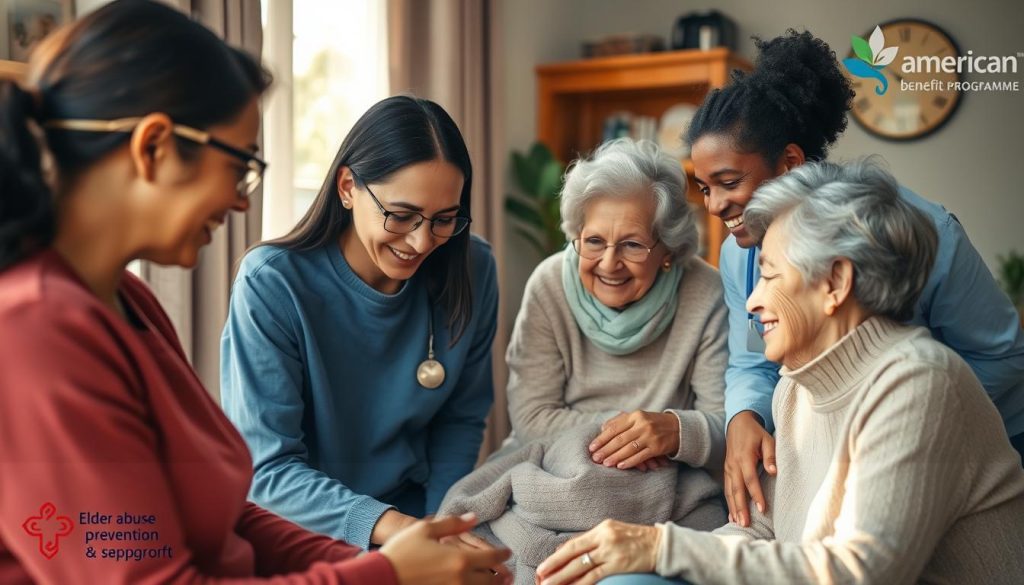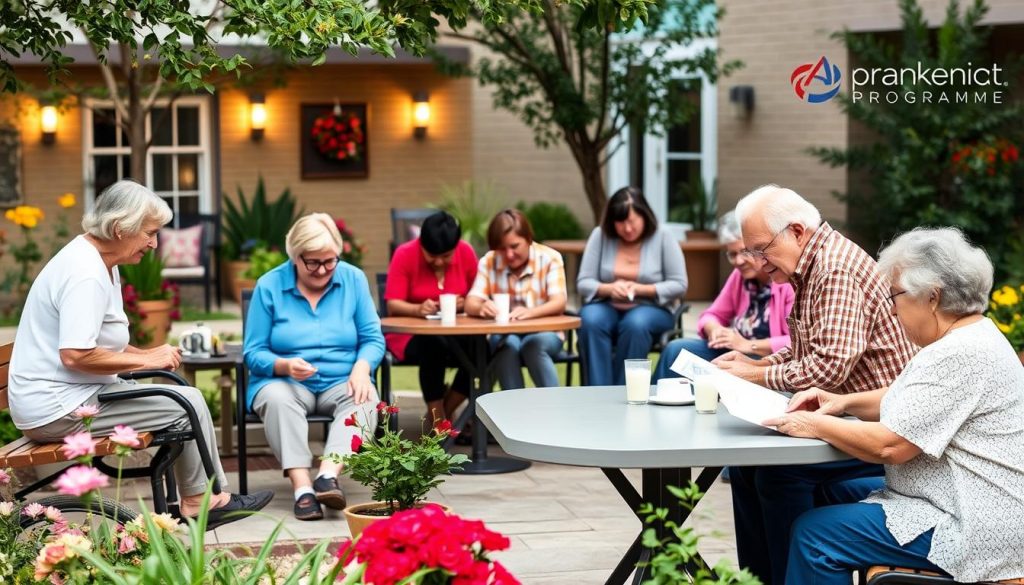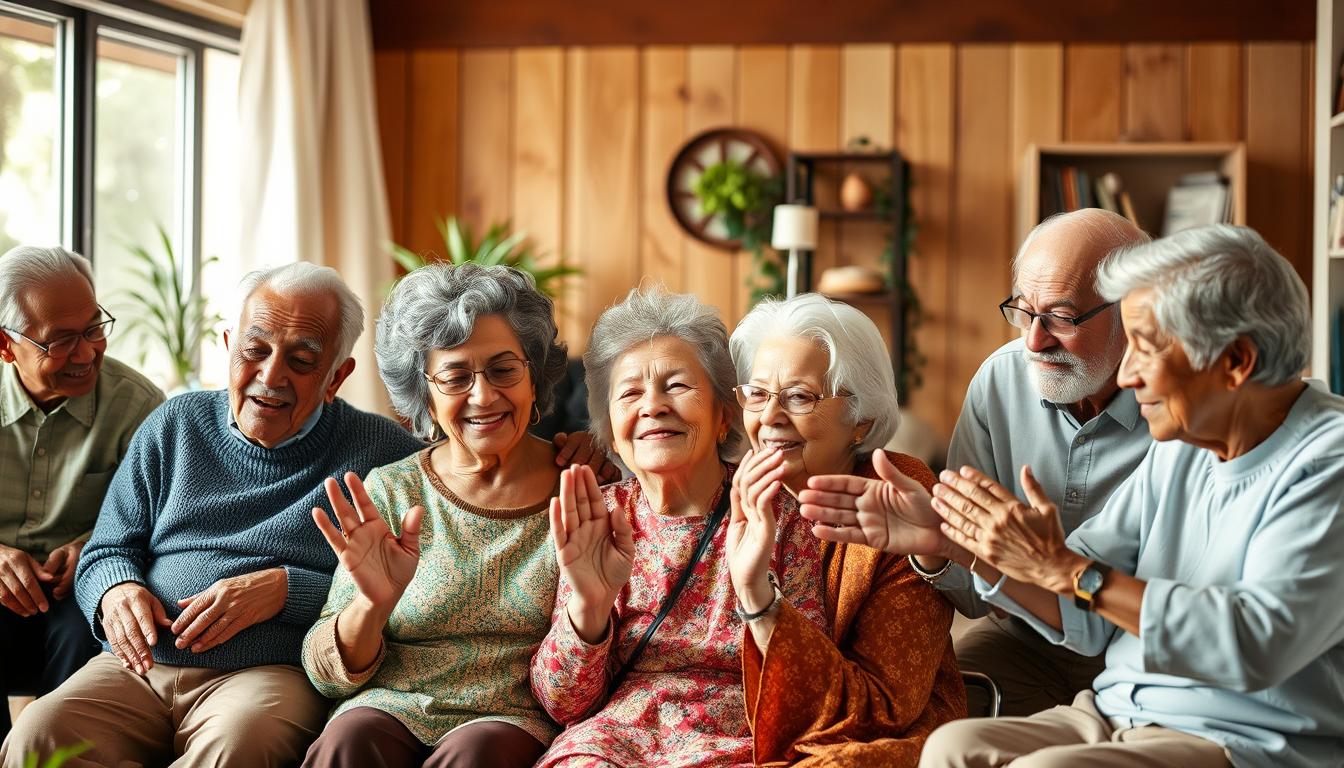How do we keep those who cared for us safe? How can we protect them from abuse and neglect?
Each year, about 1 in 10 seniors over 60 face abuse. This includes neglect, physical harm, and financial harm1. As more people get older, it’s important to know how to protect them. World Elder Abuse Awareness Day on June 15 helps us learn and support seniors2.
We must act to stop elder abuse. By knowing the risks with caregivers and places, we can keep our seniors safe1.
Key Takeaways
- 1 in 10 seniors in the U.S. experience some form of abuse.
- Focused vigilance is essential in recognizing signs of elder abuse.
- Community support plays a critical role in prevention efforts.
- Awareness of caregiver risk factors can help in mitigating abuse.
- Elder abuse can take many forms, requiring comprehensive education and resources.
Understanding Elder Abuse: Types and Signs
Elder abuse harms or risks harm to older adults 60 and up. About 1 in 10 people in the U.S. face some abuse. Women or those assigned female at birth (AFAB) are more likely targets3. Abuse can be:
- Physical Abuse: Includes hitting, slapping, or wrongly restraining someone.
- Emotional Abuse: Making someone feel bad with insults, threats, or leaving them alone.
- Sexual Abuse: Unwanted sexual touch with an older person.
- Neglect: Not giving basic needs like food, water, or health care.
- Financial Exploitation: Taking or misusing an elder’s money or things.
It’s very important to spot elder abuse signs early. These signs can be bruises or broken bones for no clear reason. Other times, it can be sudden sadness, not wanting to see other people, or money changes4. Emotional issues might show in being very quiet or having problems with the person taking care of them.
Not getting enough food or living in a dangerous place can mean someone is being neglected. Those with dementia are at a higher risk of being mistreated. Family and caregivers must learn and watch out for these signs. The more we know, the better we can protect and help stop elder abuse.
Why Elder Abuse Prevention is Critical
Stopping elder abuse is very important. It harms a lot of older people. About 1 in 6 people who are 60 and older were hurt or treated badly last year5. This abuse can hurt them physically, make them feel very sad, and even cause death. So, we must work hard to stop it.
Also, elder abuse costs older people over $28 billion a year6. With more people getting older, the issue could get worse. By 2050, there could be over 2 billion people 60 or older. This could mean 320 million might face abuse5. These numbers show why we need to act now to prevent elder abuse.
About 11.6% of older people say they have been mentally abused5. But, the sad fact is, only 1 out of 24 cases gets reported6. We need to make more people aware of this issue. By teaching them what to look out for, we can keep our seniors safe.
It is very important to prevent elder abuse. It’s about keeping our older friends and family safe and happy. Everyone, including doctors, social workers, and regular people, can help. Together, we can protect our elders and treat them with the respect they deserve.
| Statistic | Source |
|---|---|
| 1 in 6 older adults experienced abuse in community settings | 5 |
| Annual losses from financial abuse exceed $28 billion | 6 |
| By 2050, 320 million abuse victims projected globally | 5 |
| 1 in 24 cases reported to authorities | 6 |
| Psychological abuse reported by 11.6% of older adults | 5 |
Elder Abuse Prevention: Key Strategies to Implement
It’s key to keep our seniors safe. Spotting abuse signs is a main step. This means knowing what to look for. It helps protect seniors from harm.
Recognizing the Signs of Abuse
Older folks can face different abuses like physical or emotional harm7.About one in ten at home might be harmed. It shows we need to be watchful. Strange injuries or sudden money issues are red flags. Knowing these can lead to helping in time.
Encouraging Social Interaction
Being social helps older people feel less alone. Abuse often happens when they’re isolated. Friends can spot if something’s wrong. This helps keep seniors safer. It builds their defense against being mistreated.
Staying Informed about Community Resources
Knowing local help spots is good for preventing abuse. The Eldercare Locator gives important service info7.Adult Protective Services check abuse claims7. Knowing these places lets us help fast. It shows we’re all in this together.
Teaching about safety programs helps too. Every state has help for elder safety. Making campaigns against abuse is powerful. It creates safer places for our elders.
Learn more about recognizing abuse signs
By adding these steps to our routines, we make life better for elders78.
Identifying Risk Factors for Elder Abuse
It’s important to know what causes elder abuse to stop it. Many things make abuse more likely. Some of these are problems with caregivers or the places where elders live. Knowing these helps keep seniors safe and stops elder abuse.
Caregiver Risk Factors
Caregivers are very important in elders’ lives. But they face challenges that might lead to abuse. Stress, tiredness, and not being happy can make caregivers act badly towards elders. This shows why it’s key to look after their mental health9.
Bad behavior in the past can affect how caregivers act now10. Some caregivers struggle to handle stress, affecting about 3% of them. This makes them more likely to harm elders11. Also, if caregivers lose friends or lack support, they may feel alone. This can make it harder for them, increasing abuse risks9.
Institutional Risk Factors
Nursing homes have their own problems. Not having enough staff or the right kind of staff can make abuse 9% more likely11. If staff don’t get proper training, abuse and neglect can happen more. Knowing these problems helps make nursing homes safer.

Protecting Seniors from Abuse: Practical Tips
Including seniors in fun activities can help keep them safe. When elders join in on physical, mental, and social activities, they feel happier and more connected. This can make them feel less alone, which helps prevent abuse. Getting involved in things like community events, volunteer work, or exercise classes can make a big difference in their lives and help stop elder abuse.
Engaging Seniors in Activities
Being part of group activities can help elders make friends and find support. This is important to stop them from feeling lonely, which can lead to neglect. It’s also very important for seniors to learn how to stay safe online. They should know how to spot fake emails and keep their personal info secure. Checking on their money matters with someone they trust can help spot scams. This includes strange bank activity or changes in their will12.
Supporting Primary Caregivers
Helping those who take care of elders is key to preventing abuse. Sharing the caregiving load or offering support can reduce stress, lowering the risk of abuse. Talking openly about the hard parts of caregiving helps seniors and caregivers work out problems together. Regular talks with caregivers can make sure they feel okay asking for help, making a safer space for elders13.
Stopping Elder Abuse: Reporting Procedures
Knowing how to act is key when you think an elder is being abused. We need to know how to report it right, so we can stop the abuse. This way, the authorities can step in and keep the elder safe.
How to Report Abuse
If you suspect elder abuse, first call local Adult Protective Services (APS) or the police. You must give a clear report of what you think is happening. The Department of Justice says it’s very important to have professionals involved in stopping elder abuse14. In many places, doctors and other workers must report if they think someone is being harmed15. Acting fast can protect someone from getting hurt.
Whom to Contact for Help
You can also get help from APS, the police, and other groups fighting elder abuse. Doctors are great at spotting abuse and can tell you how to report it16. You can call places like the National Center on Elder Abuse for advice. Teaching everyone, including the elderly and their families, to report abuse makes a safer place for our elders.
Preventing Elder Financial Exploitation
Financial abuse of older people is a big problem. It really affects their life. Knowing how to keep money safe is important for them and their families. It’s key to stop this abuse by learning what dangers to look out for. This keeps seniors’ money safe.
Educating Seniors on Financial Safety
Talking about how to stay safe with money is vital. It includes spotting scams and keeping information safe. Talking with family members often helps seniors be aware of financial dangers. They should know about weird bank activities or if someone uses their ATM card without permission17.
Many seniors might find it hard to notice scams because of memory problems18. This means families need to help them understand how to protect their money.
Recognizing Financial Scams
Knowing about scams is the first step in protecting elders. Scammers try to trick people by making them feel rushed17. Elders might get asked for money suddenly or hear about an amazing deal. This is even tougher for those with memory issues or Alzheimer’s disease, which affects about 11% of people over 6518.
Sadly, sometimes family members are the ones taking the money17. That’s why it’s crucial to watch over personal connections. Giving seniors the tools to report abuse helps them stand up for themselves.
| Warning Signs of Financial Exploitation | Potential Indicators |
|---|---|
| Unusual Bank Withdrawals | Frequent or large withdrawals not typical for the individual |
| Changes in Account Services | New services or accounts opened that the elder does not understand |
| Unpaid Bills | Late payments despite having sufficient income |
| Sudden Changes in Will or Trust | Last-minute changes to legal documents without clear reasoning |
| Withdrawal of Dependency | Family members taking over financial decision-making abruptly |
Helping seniors stay up-to-date and involved with their money helps reduce abuse risks.
Supporting Elder Abuse Prevention Programs
Community involvement is key to elder abuse prevention success. Such programs raise awareness and motivate action against mistreatment.
Community Awareness Campaigns
Education on elder abuse is crucial through community programs. The Institute on Aging’s program educates on preventing and reporting abuse19. It provides resources to help elders stay safe from scams and harm19. More awareness can lead to higher reporting, which is still too low20.
Getting Involved Locally
Local involvement boosts prevention efforts. Volunteer at senior centers or join in programs like SASS19. These actions build community bonds and safeguard elders. They make sure help is there when needed. Reporting abuse is critical as many cases go unnoticed20.
Resources for Elder Abuse Prevention
Safeguarding seniors is crucial. Government and non-profit groups offer help and information. They empower communities to fight elder abuse.
Government and Non-Profit Organizations
Some groups focus on elder abuse prevention. The National Adult Protective Services Association (NAPSA) was formed in 198921. The National Association of State Units on Aging (NASUA) works with agencies for older populations21. The International Network for the Prevention of Elder Abuse (INPEA) shares information globally21. The American Bar Association (ABA) Commission on Law and Aging helps protect seniors’ legal rights21.
Hotlines and Helplines for Immediate Support
Hotlines and helplines offer quick help. The Eldercare Locator connects people to aging services at 1-800-677-111622. For legal help, contact the Legal Services Corporation22. The National Council on Aging’s BenefitsCheckUp aids those over 5522. To report financial scams, call the Social Security hotline at 800-269-027122. The Florida Abuse Hotline at 1(800)96-ABUSE (1(800)962-2873) handles elder abuse reports23.
| Resource Name | Contact Information | Purpose |
|---|---|---|
| Eldercare Locator | 1-800-677-1116 | Connects with local services for aging assistance |
| Legal Services Corporation | Visit website for local programs | Provides free legal help to low-income individuals |
| National Council on Aging | BenefitsCheckUp service | Helps seniors find money-saving benefits |
| Social Security Fraud Hotline | 800-269-0271 | Reports stolen Social Security numbers or scams |
| Florida Abuse Hotline | 1(800)96-ABUSE (1(800)962-2873) | Reports suspected elder abuse |
How to Foster a Safe Environment for Seniors
Making a caring space for older people is key to stop elder abuse. It’s all about building trust and keeping open talks. With regular meet-ups, it gets easier to check how seniors are doing.
Creating a Trusting Relationship
Getting close to seniors helps keep them safe. By being there a lot, caregivers show they care. This makes a place where seniors feel okay sharing their thoughts and worries. Adding clear rules about reporting abuse helps a lot, making everyone feel secure to report bad things24. Talking openly helps caregivers spot when seniors are upset, cutting down on harm25.
Regular Check-ins and Communication
Seeing and talking to seniors often is vital for safety. Listening well during these times helps caregivers get how elders feel. Quickly acting on any problems stops health from getting worse. Working with groups that help seniors makes support better, helping to keep them safe24.

Empowering Seniors Against Abuse
Teaching seniors to stand up for themselves is key to stopping elder abuse. They learn about their rights and the types of abuse through workshops. This knowledge helps them stay safe.
Providing Educational Workshops
Special workshops for seniors teach them how to prevent abuse. They learn to spot financial wrongdoings, what caregivers should do, and who to call for help26. In the U.S., around 5 million older people are abused each year. Sharing knowledge is vital for their protection.
Encouraging Self-Advocacy
Seniors speaking up for themselves helps keep them safe. They learn to stand firm and protect their rights. Programs like advocacy programs are there to guide them. It’s crucial since elder abuse often goes unreported26
| Type of Abuse | Signs to Look For |
|---|---|
| Physical Abuse | Bruises, unexplained injuries, denial of basic needs |
| Emotional Abuse | Intimidation, threats, humiliation |
| Financial Abuse | Unusual spending, bills unpaid, new people around |
| Neglect | Lack of hygiene, dirty home |
| Sexual Abuse | Infections or bruises in private areas |
Having workshops and teaching self-care are vital in fighting elder abuse27. When seniors learn these tools, they become strong and alert. This helps them fight and report abuse.
Conclusion
It’s key to stop elder abuse and work together on this. About 10% of older adults face abuse. Sadly, few of these cases get reported to people who can help28. We all should know about the types of elder mistreatment. And it’s vital to protect seniors from harm29. To make a safe space for our seniors, we need to support educational and local programs.
To prevent elder abuse, we need to recognize abuse signs. We also must help seniors connect with others30. Helping families and caregivers is also key. They are very important in defending and supporting seniors.
Keeping our elders safe involves awareness, resources, and help from the community. By joining forces, we can treat our aging loved ones with the care they deserve. This empowers them against abuse. It also builds a better future for them282930.
Source Links
- Elder Abuse Prevention – Can Elder Abuse Be Prevented?
- About Abuse of Older Persons
- Elder Abuse: When To Get Help
- Understanding and Preventing Elder Abuse: Types, Signs and Tips for Families and Caregivers
- Abuse of older people
- Get the Facts on Elder Abuse
- Elder abuse: How to spot warning signs, get help, and report mistreatment
- preventing-elder-abuse-and-neglect
- Risk Factors and Indicators | Adult Services
- NCEA | Risk Factors & Protective Factors
- Risk and Protective Factors
- Preventing Elder Abuse: A 10-Step Guide for Safeguarding Our Seniors
- Preventing Elder Abuse | SeniorLiving.org
- Ethical Considerations – Elder Abuse and Its Prevention
- Preventing Elder Abuse: Ethical Duties in Assisted Living
- Prevention of Elder Abuse, Neglect, and Exploitation
- Protect Older Americans from Financial Exploitation
- Consumers: Preventing Elder Financial Exploitation
- Elder Abuse Prevention Program – Institute on Aging
- Elder Abuse Prevention — WISE & Healthy Aging
- Resources
- How to find help responding to elder financial abuse | Consumer Financial Protection Bureau
- Elder Abuse Prevention | ElderSource
- Creating a Culture of Care: Preventing Abuse in Elderly Care Facilities
- Elder Abuse Prevention
- Empowering older adults in the fight against elder abuse
- Tip Sheet: Preventing Elder Abuse and Neglect in Older Adults
- Interventions for preventing abuse in the elderly
- Elder Abuse – Conclusion
- How to prevent elderly abuse – Knowledge Base – Justpoint

Leave a Reply